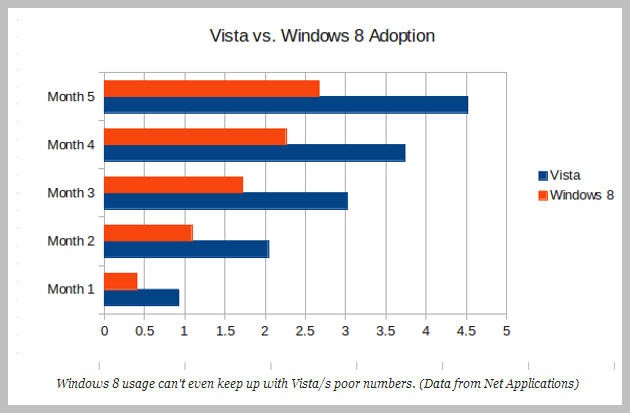Maybe not the writing, but the following graphics will create no great cheer in Redmond.
Look at the Trends for Microsoft languages based on the Tiobe Index
First, Apple’s Objective C is surging in popularity. But of greater concern is the peaking of C# and Visual Basic. Python is now more popular than VB. But even more critical is that despite Redmond funding Windows 8 developers the apps are largely me-toos. Yes, Windows now has nearly 100,000 apps in the Windows Store.
But look at this line up from the 25 Top Windows 8 apps:
This is hardly the stuff of killer apps.
And this game is really me-too – a top 25 Windows 8 app?!
This award winning photo editing app barely can contend with online tools like Picasa and SumoPaint.
The RT Conundrum
But of even greater concern may be the disappointing sales of Windows 8 RT. In January of this years sales were expected to be 4-5 million from launch whereas the real number was estimated to be well south of 2 million units sold. The conjecture is that this is due to the fact that Win 8 RT offers even less than Windows 8 on PC. The price for the hardware is as high as Windows 8 PC, there are no compelling, killer RT Apps, and in fact nearly everything that runs on Windows 8 RT also runs on Windows 8 PC version.
And despite the one time software development incentives from Redmond, developers are staying away as evidenced by the slow growth in Win 8 apps and no appearance of a 3rd party killer app on either Win 8 RT nor Win 8 PC. Also hardware suppliers are reluctant to participate in an upgraded RT version.
But Even Windows 8 on the PC is Suffering
The following is a comparison of the adoption of Windows 8 versus Windows Vista. Now Windows 8 had a $500 million advertising launch with award winning Windows 8 dancing commercials among others. But that has not translated into Windows 8 sales that match Vista’s launch:
These are not good numbers when Windows 8 cannot match the ill-starred Vista launch. It may be a menacing harbinger for Redmond if this in part reflects the switch from laptop/desktop to mobile smartphones and tablets where Microsoft is playing catch up with Win Phone 8 and a losing game with Win 8 RT.
But lets return to the fundamental problem – why are developers NOT turning out killer apps for Microsoft?
My Kingdom for Developers, Developers,… Where are the Developers?
First, in the new mobile device market Apple has been the pioneer and is able to deliver huge smartphone and tablet market share at a steep price – 30% runtime fees. But Microsoft is charging nearly the same fees to Windows 8 developers but only with a small mobile market share and some one-time development “incentives”. Duh….
But there is more than the fees and lack of market share. Microsoft, despite its “Developers, Developers, Developers” mantra has treated them shabbily at times. Ask any Web developer of what they think of Microsoft and Internet Explorer. Microsoft was the first and still is the OS vendor most adamant about using proprietary tools with continuing reluctance to adopt Open Source software and standards.
Microsoft also continues to be associated with Patch Tuesdays and all the drudge security update work – not Apple nor Google. But also Microsoft Windows and IE rank along with Adobe AIR and Flash Player as the most frequently rated with high vulnerabilities by US Government CERT weekly reports for 2013. And Microsoft’s very mixed record for software reliability[“Third times the charm”] has to measured against its long update cycle and less than agile development cycles.
But perhaps most telling is not the reliability or security problems with Redmonds software but rather the cavalier fashion Microsoft may treat long time developer partners when markets start to become big and Redmond wants in. Just ask the people at Sybase, the many extinct Windows utility vendors, BI suppliers, project management tool vendors, etc, etc.
Summary
Financially things are still going very well in Redmond. Quarterly revenue was up by 3% to $24B while operating profit and earnings per share were down marginally in a period with many “specials” to be accounted for. And some key Business software like Sharepoint, Lync and SQL Server had strong double digit increases in sales.
And technically, Redmond has some feathers in its cap with Windows Phone 8 gaining praise, imitators in Blackberry BB10 and Samsung Tizen copying some of its UI innovations. And Lync 2013 is earning high praise in the communications arena with its ability to support Android, iOS, and Windows Phone 8 interactions.
But then you have the launching of Windows 8 RT, Microsoft’s first direct venture in the ARM processor powered tablet market, has been less than stellar. Windows 8 RT and PC have yet to see any “must-have”, killer apps. And the long update cycles for Redmond’s software, which may be perfect for its business programs, but is less than helpful in the fast moving mobile spaces. For example Outlook is finally coming to Windows RT – fine with business but really slow-poke for the younger consumers that Surface and Windows RT seem to be targeted for. So the internal war over agility and update speed between Consumer [Xbox, Windows RT, Windows Phone, IE + Windows Live – historically the less than stellar profitables] versus the business apps[Windows 7 + 8 PC, Windows Server, SQL Server, SharePoint, Office in its many business guises, etc, etc- all very profitable] has yet to worked out among the Redmond Development teams.
So you have 3 major coding problems at Microsoft:
1)their development tools and languages are falling in developer popularity as Mobile and Web based coding takes greater mindshare;
2)”third time charm” development is still alive and well with security and reliability and patch Tuesdays regular Microsoft “events”. This is true – even after proclamations about Trustworthy Computing and promises of faster development cycles;
3)The latter agile development is only welcome in about 40% of the Microsoft Development campus. For teams that are developing Business software 1-3 year major upgrade cycles with a stream of security/bug fix/high priority functional patches is more than good enough. But the biggest whipsaw is with developers.
The CEO says Microsoft is dedicated to developers, developers, developers. But many of those developers will see 30% runtime fees for the privilege of selling their software onto a broader set of Microsoft Operating Systems. This has had a most telling effect on the attitude of developers. As a colleague and longtime Microsoft developer noted – “with poor or declining market share, but the same 30% runtime fees, and the real possibility Microsoft will simply move in and take-over a market we have spent months and years developing, I am taking a brand new approach to development and its not with Redmond”. Not just Microsoft, but all 3 major OS vendors better beware – their brand and mindshare among developers really matters because there are still big openings available in the mobile and Virtual/Cloud operating system spaces.





